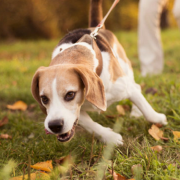Bad Human! Behaviors You Should Not Encourage in Your Dog
Most dog parents want a well-behaved dog, but sometimes pet parents unknowingly encourage naughty behaviors that can make life at home and in the community less then ideal. These behaviors can develop slowly over time, after years of going uncorrected. Sometimes a single episode of bad behavior that goes uncorrected can tell your dog that the behavior is ok, and it’s set in stone. Training is key to ensuring your pooch is minding his manners, but it’s also important to be aware of what bad behaviors you might be enabling. Dogs take their cues from their humans, and if you don’t help them understand how to behave, they’ll make those decisions on their own.
Here are a few bad behaviors that dog parents often encourage in their pets.
Jumping
Dogs may like to show their unbridled affection by jumping up on you. You may think this is adorable and pat our dog and laugh in response to this action. Doing so, however, actually tells him that you like it when he hops all over you. While you may not mind this behavior, the fact is, jumping up is not a welcome behavior by everyone, and if you don’t discourage it right away, it gets harder to stop your dog from doing it in the future.
To prevent your furry friend from jumping, ignore the behavior—totally. Any attention, even scolding your dog when he leaps on you, could encourage the bad behavior. When your dog jumps up, either do nothing or turn your back on him. Wait for him to calm down, and only interact with him when all four paws are on the floor. If he jumps up again, repeat the process and turn your back until he stops.
Nipping and Biting
Puppies are nippy when they’re teething, but this generally ends within a few weeks if the appropriate steps are taken. When steps aren’t taken to curb nippy behavior in the teething stages, your dog may grow into an adult thinking it’s okay to communicate with teeth on skin. It’s not.
Curbing nippy behavior in an adult dog isn’t as easy to do as it is with a puppy, but the approach is the same for any dog at any age. At the exact moment that your dog’s teeth touch you, let out a shrill “ouch!” and then walk away for thirty seconds. If your dog is mouthy while playing with him, mark the moment he mouths you with an “ouch,” drop the toy and walk away. The combination of the “ouch” cue and the withdrawal of your attention will soon help your dog understand that you don’t want to be used as his chew toy.
Begging
Dogs have a way of looking at you with their sad eyes and convincing you that they are starving. In that moment, it’s hard not to remember that you just fed him dinner and that breakfast is not that far away. Many pet parents can’t resist their dog’s pitiful stare and end up sharing what’s on their plate. How could you not? You love him so much! This form of generosity is kind, but in reality it sets you up for a lifetime of sharing your food with your dog.
Rather than putting yourself in a position of giving in to his begging, keep your dog focused on something else while you’re eating. Find a toy or bone that can be stuffed with treats and give it to your dog during your meal time. Your dog can spend this time focused and occupied with his own treats. If he’s a master at extracting those treats from his toy and resorts to begging again, simply ignore him.
Leash pulling
Humans can totally be a drag! When your dog is out for a walk, he’s got things to do…he’s got to sniff the fire hydrant and pee on telephone pole and find that pesky squirrel that taunts him daily. He doesn’t have time to be slowed down by his human and he is going to do what he’s got to do to stay on task, even if that means pulling his human along behind him. Pulling is a behavior that can creep in slowly. We may unwittingly allow our dogs to pull now and then and don’t realize what that actually teaches them. Dogs can learn quickly that a tight leash means “go forward,” so a feeling of tension around their necks becomes the set point for walking.
Dogs need to learn that a loose leash is the path to forward momentum. That means you have to make sure that when he pulls, he doesn’t get to go. When your dog pulls on his leash, stop walking. It’s important to do this every single time he pulls. When he circles back to you, or even looks back at you, offer him a treat right next to your body, make him sit, give him the treat and continue walking. You can also reward your dogs with treats intermittently as he walks by your side, giving him the cue that when he’s walking next to you, he’s doing a good thing.
Barking
A dog that barks to get you to do his bidding is being bossy. When you give in to his demands, you enable his pushy behavior. While it is understandable that heeding your dog’s demands is the simplest way to get the noise to stop, reacting to demand barking teaches your dog that being obnoxious is more effective than being polite.
Your mom probably taught you to say “please” when you asked for something. Well it’s not unimaginable to think that your dog can do the same thing. Encourage a more polite behavior by having your dog sit for everything he wants. Get him to sit before you place his food bowl on the ground or toss him his favorite toy. You can even make him sit before he gets to run through the door out into the yard. Not only can you teach your dog the behavior you expect from him, you can also teach him that barking never gets him what he wants. If he barks at you while you are preparing his dinner, stop what you are doing and walk away. If he is insistent that you throw that ball right now, drop it and do something else. He’ll quickly learn that barking makes you do the opposite of what he wants.
Training your dog to be a well-behaved pooch takes time and effort. It also requires being aware of the signals we send our dogs. Recognizing our enabling behaviors is critical to ensuring good manners in our furry friends.



